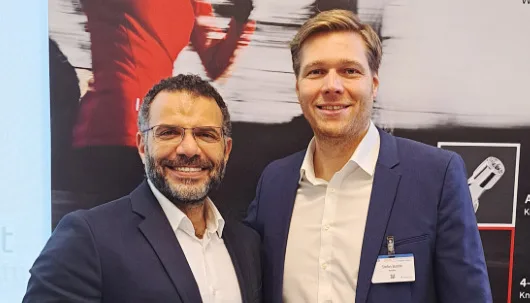
22 Feb EKB 2024: One system for all cases

Dr. Stefan Budde, Bielefeld and Dr. Ahmed Yaseen, Innsbruck
EKB 2024: One system for all cases
The speakers Professor Dr. Stefan Budde, Bielefeld, and Dr. Ahmed Yaseen, Innsbruck, discussed with the participants of the ARTIQO workshop as part of the Endoprosthetics Congress Berlin 2024 how the A2® short stem system can become a system for all cases.
The advantages of the short stem treatment
Why actually short stams when standard stems do their job reliably? The short stem concept was originally conceived to prevent distal force introduction, Professor Budde recalled the beginnings. Since then, various implant philosophies have come onto the market and disappeared again. Today, there are many advantages to using modern calcar-guided short-stem systems: On the one hand, they save bone through reduced stress shielding, protection of the trochanter and a higher bone resection. They also enabled more physiological joint function through better reconstruction of the anterior offset, more physiological muscle function, lower risk of dislocation and a more minimally invasive implantation technique. And finally, these systems are safe, as the revision rates in the German Endoprosthesis Register (EPRD) show. Of the 67 hip stem systems examined in the EPRD, short stems have been in the top 3 for several years. Thanks to the registry data, it was found that the infection rate of short stems is significantly lower compared to standard stems[1]. And an RSA migration analysis of the A2® short stem showed that the implants stabilized quickly and completely after an expected initial migration and demonstrated good osseointegration. This allows us to draw conclusions about a good long-term prognosis for the implant.
The goal: complete indication coverage
With all of these advantages, says Professor Budde, the question arises as to why one should not only use short stems. Ultimately, it is a question of indication coverage: The A2® short stem system with the “two body” design concept already addresses varicose veins, normal and valgus femora and various femur morphologies.
Dr. Yaseen added that the EPRD advocates cemented restorations for patients aged 75 and over. There is also no recommendation for a cement-free short stem for Dorr type C morphologies. In order to close this gap in short stem care, the cemented A2® short stem variant has been available for three years as a solution for older patients and as an addition to the range for Dorr type C morphologies and osteoporotic bone structure.
On behalf of Dr. Bertram Regenbrecht reported to Dr. Yaseen talks about her first experiences with the cemented short stem in Lilienthal. Around 130 implants were inserted there using the “Direct Anterior Approach” using a medullary canal block and jet lavage. The cementation was chosen to be one size smaller than grated. Around 100 cases were treated electively in patients with Dorr type B and C femora, in patients with relevant osteoporosis and in old age. In addition, the system was used in 30 cases of medial femoral neck fractures with a preserved calcar.
Lilienthal is participating with three other centers in a multicenter user observation study on the cemented A2® short stem. Patient recruitment has been completed with 90 women and 31 men. The average age of the patients is 77.8 ± 4.7 years.
The stem design produced consistently inconspicuous and good results. The clinical scores (HHS and FJS) showed very encouraging results. The average FJS at 1-year follow-up was comparable to the results of non-implant recipients. As expected, the patient clientele presented challenges: Due to the old age of the patients, an increased drop-out rate was observed during follow-up. Complications and abnormalities also arise from the age and comorbidities of the study cohort. In addition, a revision was documented that was carried out after inadequate cementation and the resulting early postoperative sintering of the short stem. The current survival rate of the cemented A2® short stem is 99.17% after one year.
Clinical studies necessary
During the discussion, the plenum agreed that it was now necessary to carefully determine the indication for the use of the cemented stem variant and to ensure consistent clinical study support. In this way, the spectrum of indications can be broadened step by step, as with a classic standard system.
[1] Steinbrück, A., Grimberg, A.W., Elliott, J. et al. Orthopedist 50, 296–305 (2021). https://doi.org/10.1007/s00132-021-04083-y
More Information:
The A2® stem impresses with low migration and good ingrowth behavior
